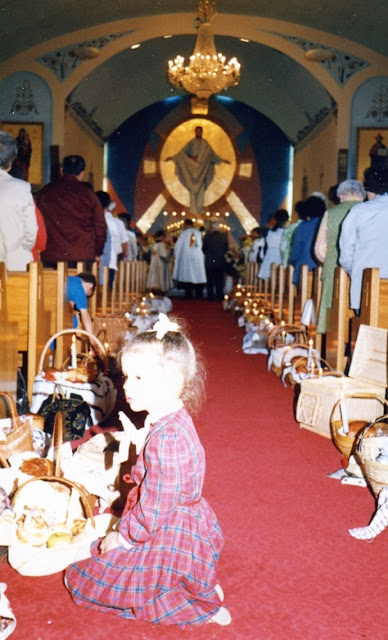One of the Breads that is made at Easter is called Babka. The word Babka or Baba is the Ukrainian word for Grandmother. Folklore suggests that that Babka Bread originated in prehistoric times when women ruled Ukrainian communities. Traces of Matriarchal society are evident in folk songs, role of women in a family and the rank of women in the community. There is also Archeological finds and evidence of a Matriarchal system in ancient settlements of the Trypillyan Culture which suggest religious rituals preformed by women priestesses. Some of the rituals connecting with fertility of soil may have used this bread in the ritual. Certainly growing up with very strong women in my family, these findings are no surprise to me.
Babka Bread is a sweet yeast dough that has raisins and is baked in a tall cylinder container. My Mom used a large coffee tin as did many of her friends. This bread is very rich, spongy and very light due to the large number of eggs, butter, milk and sugar in the recipe.
The recipe that I have been making over the years comes from Traditional Ukrainian Cookery by Savella Stechishin.. My Mom also started to use this recipe as she did not like the Babka Bread made with a lot of eggs. My grandmother use saffron in her Babka Bread, something I was going to try but forget to add the saffron.
This recipe is very similar to the recipe that Martha Stewart's Mom made and a very lovely video is online of the two of them making Babka. Their Babka Bread was made using a Food processor and Bundt pans. The use of a food processor surprised me, given the age Martha's Mom..
Most Babka recipes start with making a sponge and letting it rise for one hour.
- Sponge
- 1 T sugar
- 1 cup lukewarm water
- 2 T traditional Yeast
- 1 cup scalded milk, lukewarm
- 1 cup flour
Mix in the flour and milk. Let sit for for about an hour, until the sponge is light and bubbly.
- 6 eggs
- pinch of salt
- 1/2c sugar
- lemon juice and rind
- 1c butter, melted
- 1 tsp vanilla
- 1c Golden Raisins
- 1c Citron peel
- 5 1/2 c flour
Beat eggs, gradually add sugar while beating the mixture
Beat in butter, vanilla and lemon
Combine with the sponge mixture.
Add in the flour a cup at a time and mix with spoon until you can no longer do this
Knead the dough until it is smooth and does not stick to your hands. Add in the raisins, glazed fruit and knead until this is incorporated into the bread.
Cover with saran wrap and let rise until double in size.
Prepare the pans, grease well and use parchment to the line the tin cans.
Fill the tins about 1/3. This recipe uses about 3 coffee tins. When forming the Babaka, make sure the top is smooth for a nicer looking bread
Let rise until double in size.
Bake at 350 for 30 to 40 minutes. Some recipes suggest a hot oven for 10- 15 minutes, then 350 for the rest of the baking time.
Adjust the baking time for the of the size pans.
Cool on a soft surface and turn to prevent setting..
This is something I forgot to do and my bread did settle. I did take them out too quickly from the tin and cooled them on wire rack and they did settle on one side.
Do check out Martha Stewart delightful video of her Mom making Babka..
I have compared the different portions of three recipes, one is the Country Babka, Martha Stewart's Mom and one my sister makes which is out to the Roblin Manitoba Catholic Women cookbook. My sister recipe is very close to mine. Martha's Mom uses more milk, thus she needs more flour to make her recipe. Yet all of them do not use tons of eggs as most Babka recipes do!































































